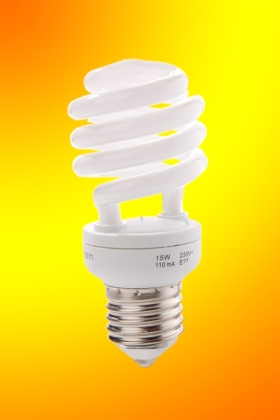Article from Energy Saving Trust
<span>Compact Fluorescent Lamps (CFLs) are a modern type of light bulb that will fit into a standard light fitting, usually a bayonet fitting in the UK, but CFLs are also available with Edison screw fitt...span>

Compact Fluorescent Lamps (CFLs) are a modern type of light bulb that will fit into a standard light fitting, usually a bayonet fitting in the UK, but CFLs are also available with Edison screw fittings. Most CFLs either consist of a number of short glass sticks, or two or three small tubular loops. Sometimes, these are enclosed in a glass bowl or made to look like a traditional bulb. There are also some older CFLs that look light a clear or white glass jam-jar and are much heavier, but these are less efficient and are not recommended. CFLs work in much the same way as a fluorescent strip light: the inside is coated with a phosphor that gives off the light and there is an electronic ballast to start the lamp operating. CFLs are often called low energy lamps because they use less energy than the traditional tungsten filament bulbs that they replace. As they plug in directly to the normal light fittings they work off the UKs standard 230V supply and should not be confused with low-voltage lamps which do not offer significant energy or cost savings.
**What wattage CFL should I buy?
**
Compact Fluorescent Lamps are sold by the wattage, in much the same way as normal bulbs. However because they use a lot less energy, a lower wattage bulb will be needed to give out the same amount of light. view our energy saving chart.
**So how do the CFLs save money?
**
Although CFLs cost more to buy, they save money because they use less electricity.
Ordinary Bulbs
CFLs
40W
7 - 10W
60W
15 -18W
100W
20 - 25W
150W
32W
The cost of a low energy light bulb can be as low as £2 and they are now available in most retail stores. As the CFL will typically last for a total of 8,000 hours, the savings over its lifetime could reach £35! Compact Fluorescent Lamps are best used in areas with a fairly high usage. If a light is used for an average of 3 hours per day over the year (perhaps 1 hour in mid-summer and 5 hours in winter), then it would pay for itself in less than a year. On the other hand if it was only used for an hour a day on average, it would take 2½ years to recover the initial cost. We also advise people to use well known brands of CFLs from a reputable store. There were some cheaper lamps, often made in the Far East, that lasted less long. Although it was still possible to make some savings with these bulbs, they often proved to be a false economy.
Should I leave CFLs on when I leave a room to keep saving money?
No! There used to be a general belief that because fluorescent strip lights used more power in their warm-up phase, then it was better to leave them on all the time. This was never true - an old style strip light (or non-electronic CFL) only uses as much energy in the warm-up phase as it does whilst operating for a minute or so, and modern electronic ballast CFLs use even less energy at the start. Although CFLs do not use much electricity it is still best to keep them switched off when not wanted - why throw money away on anything that not needed?
